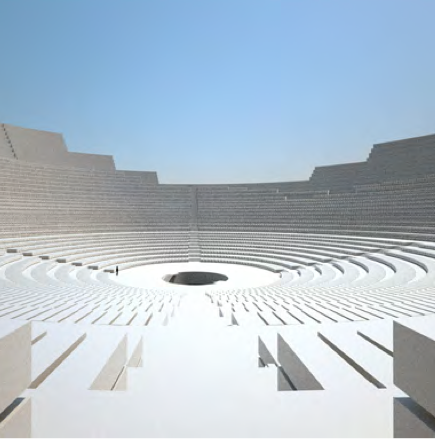In 2013, the Texas based Miro Rivera Architects (MRI) presented their design for a cemetery in the Dead Sea. The practice presented the cemetery as “Yarauvi” and refers to the structure as a necropolis rather than a cemetery — and it only takes one look at the design’s hefty nod to Greek architecture to understand why.
“The practice refers to the structure as a necropolis rather than a cemetery — and it only takes one look at the design’s hefty nod to Greek architecture to understand why.”
There’s something inherently sublime about the Dead Sea. Bordering Jordan, Israel and Palestine, the “Salt Sea” (imagine yourself floating in a 33% saline pool) has been an attraction of early western civilization for thousands of years. That reputation hasn’t changed much today, with tourists flocking to visit the earth’s lowest known elevation on land. Besides, what other seaside resort has bragging rights going back to the days of Herod the Great? When you’re in the Dead Sea, you’re swimming in the world’s most ancient history.
Yarauvi’s pillars would support an amphitheater-like structure reminiscent of the region’s Mediterranean roots. A parabolic form is created from “concentric rings supported on a raft-like armature below the water line, which allows it to float in the buoyant salty waters of the Dead Sea,” says the practice about the structure’s design, which opens upward to the clouds. “The Dead Sea holds significance as a historical space between cultures, both literally and figuratively [and we want] Yarauvi [to be] a place where any person—regardless of nationality, race, religion, age or affluence—can be laid to rest.”
“A parabolic form is created from concentric rings supported on a raft-like armature below the water line, which allows it to float in the buoyant salty waters of the Dead Sea.”
Miro Rivera says the idea is to accumulate “individual sarcophagi” that will “progressively fill the stepped structure, laid out in a concentric configuration facing one another.” In that way, they will be building a sense of community rooted in the ancient forms of architecture. “By choosing this site as a final resting place,” they explain, “any citizen of the world can contribute to a growing monument to tolerance, reconciliation and unity.”
What do you think about the concept of Miro Rivera’s necropolis? We look forward to your comments below.
You may enjoy:
- New Jersey’s Teardrop Sculpture: The controversial 9/11 memorial by Russian artist Zurab Tsereteli
- A Community of Cremation Vessels: Cloud of Stars by Zhufei Zhufei
- Friedhof for All: Austria’s Modern Islamic Cemetery

 Yarauvi: A Cemetery in the Salt Sea
Yarauvi: A Cemetery in the Salt Sea






 Having an Estate Plan Is Essential – So Is Discussing It With Your Children
Having an Estate Plan Is Essential – So Is Discussing It With Your Children
 The Healing Sound of Singing Bowls
The Healing Sound of Singing Bowls
 “Summons” by Aurora Levins Morales
“Summons” by Aurora Levins Morales














